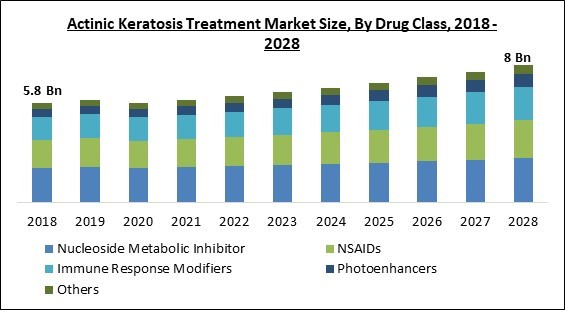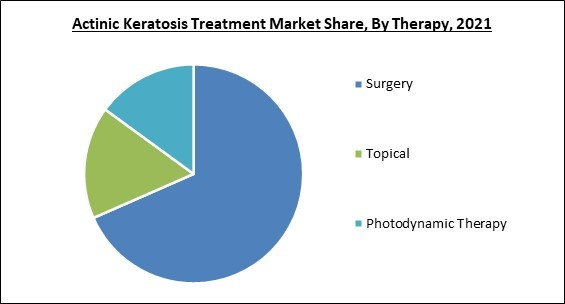The Global Actinic Keratosis Treatment Market size is expected to reach $8 billion by 2028, rising at a market growth of 4.4% CAGR during the forecast period.
Actinic keratosis is the most frequent precancer that develops on skin that has been chronically damaged by ultraviolet rays emitted by the sun or/and indoor tanning. This disorder is also referred to as solar keratosis. If someone already has an AK, they are more likely to go on to acquire further actinic keratoses. Since AKs can turn into squamous cell carcinoma (SCC), a frequent and occasionally invasive form of the illness, this increases the risk of developing skin cancer.
Squamous cells, one of the three primary cell types in the epidermis, are flat cells close to the skin's surface that continuously shed as new ones develop. Squamous cell carcinoma (SCC) develops when aberrant squamous cell alterations result from DNA damage brought on by exposure to UV radiation or other harmful factors. SCCs can manifest as elevated developments with a central depression, open sores, scaly red patches, and rough, thickened, or wart-like skin. SCCs can develop in various additional body parts, including the genitalia.
The skin precancer actinic keratosis is quite widespread. Knowing the risk factors and the causes of AK can assist individuals to stop it from happening. It is easier for people to identify AKs early on when they are very curable if they are aware of the disease risk. Sun exposure causes cumulative skin damage. This implies that the risk of developing AKs increases the longer people stay in the sun over time, even for small durations.
This includes persons who work outside in the sunlight, those who have thinning hair or a bald head, and those with sunburns. The UV rays that indoor tanning beds emit are particularly hazardous since they increase the risk of getting AKs and other forms of skin cancer. More people are exposed to the damaging effects of the sun when they live near the equator where UV rays are high for most of the year. Therefore, those who reside in areas near the equator have a higher chance of developing AKs.
The market research report covers the analysis of key stakeholders of the market. Key companies profiled in the report include Almirall, S.A, LEO Pharma A/S, Biofrontera AG, Sun Pharmaceuticals Industries Ltd., 3M Company, Bausch Health Companies, Inc., Novartis AG, Viatris, Inc., and Galderma S.A.
Actinic keratosis is the most frequent precancer that develops on skin that has been chronically damaged by ultraviolet rays emitted by the sun or/and indoor tanning. This disorder is also referred to as solar keratosis. If someone already has an AK, they are more likely to go on to acquire further actinic keratoses. Since AKs can turn into squamous cell carcinoma (SCC), a frequent and occasionally invasive form of the illness, this increases the risk of developing skin cancer.
Squamous cells, one of the three primary cell types in the epidermis, are flat cells close to the skin's surface that continuously shed as new ones develop. Squamous cell carcinoma (SCC) develops when aberrant squamous cell alterations result from DNA damage brought on by exposure to UV radiation or other harmful factors. SCCs can manifest as elevated developments with a central depression, open sores, scaly red patches, and rough, thickened, or wart-like skin. SCCs can develop in various additional body parts, including the genitalia.
The skin precancer actinic keratosis is quite widespread. Knowing the risk factors and the causes of AK can assist individuals to stop it from happening. It is easier for people to identify AKs early on when they are very curable if they are aware of the disease risk. Sun exposure causes cumulative skin damage. This implies that the risk of developing AKs increases the longer people stay in the sun over time, even for small durations.
This includes persons who work outside in the sunlight, those who have thinning hair or a bald head, and those with sunburns. The UV rays that indoor tanning beds emit are particularly hazardous since they increase the risk of getting AKs and other forms of skin cancer. More people are exposed to the damaging effects of the sun when they live near the equator where UV rays are high for most of the year. Therefore, those who reside in areas near the equator have a higher chance of developing AKs.
COVID-19 Impact Analysis
A significant slowdown in the supply chain, stock market volatility, deterioration in corporate morale, and rising public confusion and fear about the future are just a few of the many effects of the COVID-19 pandemic. On the actinic keratosis treatments market, the pandemic had a negative effect. Diagnose and treatment rates were significantly lower as a result of total lockdown in the majority of nations and restrictions on non-essential doctor visits. Additionally, most hospitals maintained ongoing communication with dermatologists to reduce the number of patients who visited with actinic keratosis and other non-urgent medical issues. However, the market for actinic keratosis treatments is anticipated to rise as COVID-19 limits are loosened across the board.Market Growth Factors
The Increased Use Of Minimally Invasive Clinical Procedures
There is a high prevalence of actinic keratosis as a consequence of ozone layer degradation and prolonged sun exposure. Increasing cancer cases and a strong desire for minimally invasive (MI) therapies are growing. Actinic keratosis is projected to become more common, and there will also be a greater need for therapies as people become more aware of how to manage their illnesses. The demand for actinic keratosis treatment is rising as people become more aware of its negative effects. Additionally, the frequency of identification and treatment has increased because of the higher risk of developing skin cancer linked to actinic keratosis.Expanding Government Initiatives To Increase Affordability
The number of patients undergoing actinic keratosis therapy has also been impacted by government initiatives to increase access to and affordability of healthcare facilities. In the coming years, the availability of alluring rebate programs is anticipated to stimulate demand development. Around the world, a number of public and private groups are attempting to increase public knowledge of actinic keratosis treatment options. Furthermore, actinic keratosis treatments are growing along with significant investments in research & development projects to produce novel medications with higher efficacy, convenient dosage, and cheaper pricing.Market Restraining Factors
Low Treatment Penetration And A Lack Of Qualified Specialists
The most important factor for the treatment of actinic keratosis is an effective method to control and cure it. Research and experiments have shown methods like cryotherapy and photodynamic therapy to be most effective in managing actinic keratosis. But the severe lack of qualified healthcare professionals increases the gap between the growing number of patients and the doctors who can treat it. Even for the treatment of actinic keratosis by chemical peels, qualified medical personnel and surgeons are required.Therapy Outlook
Based on therapy, the actinic keratosis treatment market is categorized into topical, photodynamic therapy, and surgery. The photodynamic segment witnessed a significant revenue share in the actinic keratosis treatment market in 2021. A non-invasive treatment for photodamage, precancerous spots, and other skin disorders is photodynamic blue light therapy. Aminolevulinic acid, a drug that reacts to light, is applied to the spot being treated. The targeted cells are then obliterated by a blue light that is then focused on the therapy area. Large regions can be effectively treated in this way.Drug Class Outlook
On the basis of drug class, the actinic keratosis treatment market is divided into nucleoside metabolic inhibitor, NSAIDs, immune response modifiers, photoenhancers, and others. The NSAIDs segment recorded a substantial revenue share in the actinic keratosis treatment market in 2021. Non-steroidal anti-inflammatory medicines (NSAIDs) work by irreversibly or reversibly acetylating COX isoforms, blocking downstream prostaglandins, and possibly acting as chemopreventatives in the case of malignancies like skin cancer.End-Use Outlook
Based on end-use, the actinic keratosis treatment market is segmented into hospitals, private clinics, homecare, and others. The homecare segment acquired a significant revenue share in the actinic keratosis treatment market in 2021. The increasing usage of topical treatments, patient comfort factors, the accessibility of over-the-counter (OTC) products, and the expanding number of topical product launches are all factors contributing to the expansion of the homecare segment.Regional Outlook
On the basis of region, the actinic keratosis treatment market is analyzed across North America, Europe, Asia Pacific, and LAMEA. The North America segment garnered the highest revenue share in the actinic keratosis treatment market in 2021. Actinic keratosis' increasing incidence, encouraging government measures, more consumer awareness, better healthcare infrastructure improvements, and continued technical breakthroughs are all credited with the rise. One of the main causes of business growth is also the existence of important players in the market in North America.The market research report covers the analysis of key stakeholders of the market. Key companies profiled in the report include Almirall, S.A, LEO Pharma A/S, Biofrontera AG, Sun Pharmaceuticals Industries Ltd., 3M Company, Bausch Health Companies, Inc., Novartis AG, Viatris, Inc., and Galderma S.A.
Scope of the Study
By Drug Class
- Nucleoside Metabolic Inhibitor
- NSAIDs
- Immune Response Modifiers
- Photoenhancers
- Others
By Therapy
- Surgery
- Topical
- Photodynamic Therapy
By End-use
- Hospitals
- Private Clinics
- Homecare
- Others
By Geography
- North America
- US
- Canada
- Mexico
- Rest of North America
- Europe
- Germany
- UK
- France
- Russia
- Spain
- Italy
- Rest of Europe
- Asia Pacific
- China
- Japan
- India
- South Korea
- Singapore
- Malaysia
- Rest of Asia Pacific
- LAMEA
- Brazil
- Argentina
- UAE
- Saudi Arabia
- South Africa
- Nigeria
- Rest of LAMEA
Key Market Players
List of Companies Profiled in the Report:
- Almirall, S.A
- LEO Pharma A/S
- Biofrontera AG
- Sun Pharmaceuticals Industries Ltd.
- 3M Company
- Bausch Health Companies, Inc.
- Novartis AG
- Viatris, Inc.
- Galderma S.A.
Unique Offerings
- Exhaustive coverage
- The highest number of Market tables and figures
- Subscription-based model available
- Guaranteed best price
- Assured post sales research support with 10% customization free
Table of Contents
Chapter 1. Market Scope & Methodology
Chapter 2. Market Overview
Chapter 3. Global Actinic Keratosis Treatment Market by Drug Class
Chapter 4. Global Actinic Keratosis Treatment Market by Therapy
Chapter 5. Global Actinic Keratosis Treatment Market by End-use
Chapter 6. Global Actinic Keratosis Treatment Market by Region
Chapter 7. Company Profiles
Companies Mentioned
- Almirall, S.A
- LEO Pharma A/S
- Biofrontera AG
- Sun Pharmaceuticals Industries Ltd.
- 3M Company
- Bausch Health Companies, Inc.
- Novartis AG
- Viatris, Inc.
- Galderma S.A.
Methodology

LOADING...










